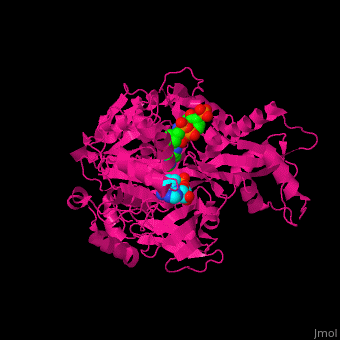Function
Acetyl-CoA synthetase (ACS) catalyzes the ligation of acetate and CoA to form acetyl-CoA with the conversion of ATP to AMP and pyrophosphate. ACS is an ATP-dependent AMP-binding enzyme. Mg+2 is ACS cofactor. ACS participates in the pathway which fixes CO2 under anaerobic conditions. ACS acetylates the response regulator for flagellar movement and for chemotaxis - CheY. [1]
Relevance
Acetyl-CoA is used in aerobic respiration to produce energy and electron carriers and for lipid biosynthesis, in histone acetylation which is critical for DNA condensation to chromatin.
Structural Highlights
- . Water molecules shown as red spheres.
- .
- (2p2j).[2]
3D structures of acetyl-CoA synthetase
Acetyl-CoA synthetase 3D structures

